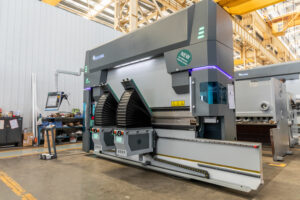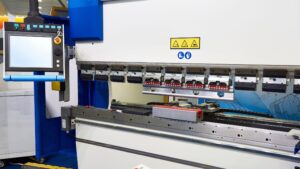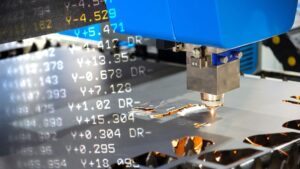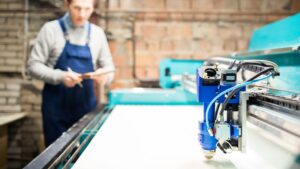Everyone will agree that technology advancement comes with its perks, and the press brake machines are proof of that.
Press brakes are mostly used for bending sheet metal materials, and you need a proper understanding of how it works to use them correctly.
So, if you have a workshop, having a press brake is a “must”. However, there are different types of press brakes and they all have their unique mode of application.
Keep reading.
What is a Press Brake?
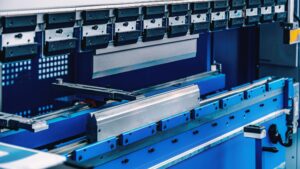
A press brake, sometimes known as a brake press, is a manufacturing machine used for bending and folding plates and sheet metal into various angles and shapes
It works by clamping the metal between a punch and a die, and applying force to create the desired bend.
What Are The Different Types Of Press Brakes?
Press brakes are utilized in metalworking industries, and they come in different types and specifications.
This section will highlight the various types of press brakes and help you understand their distinctive features.
Mechanical Press Brakes
Mechanical brakes have been around since the beginning of press brakes, and they are known for their high tonnage capacity. It operates with a clutch system and mechanical flywheel that stores kinetic energy and transfers it through a system of gears.
What types of materials are best suited for
Mechanical press brakes are suitable for bending a wide range of materials. As press brake operators, it’s important that you are familiar with operating a press brake when working on specific materials.
Some of the materials commonly used for mechanical brakes are;
- Stainless steel
- Mild steel
- Copper and Brass
- Aluminum
Common Applications
Mechanical press brakes are commonly used in metalworking and fabrication industries to bend and fold metal sheet to different sizes and shapes.
However, they are also essential in other applications like;
- Structural Steel Fabrication
- Automotive and Aerospace Industries
- HVAC Ductwork
ADVANTAGES
- Enhanced productivity
- Precise control
- Ideal for high-tonnage applications
DISADVANTAGES
- Limited speed control
- High maintenance
Hydraulic Press Brakes

The hydraulic press brake is easily the most used brake now due to its hydraulic system, and it’s driven by two hydraulic cylinders.
Hydraulic press brakes work by using two synchronized hydraulic cylinders on the C-frames to move the upper beam. They are a better option than the mechanical variant because they offer more flexibility in terms of speed control and retraction.
Hydraulic brakes can fold sheets up to 8 meters, plus they can be both down-acting and up-acting.
Also, the hydraulic press brake comes with independent cylinders; meaning folding and bending of your workpiece at different angles can be done in a single operation.
What types of materials are best suited for
Hydraulics are typically used to get accurate designs and shapes. And they are best suited for materials such as;
- Copper and Brass
- High Strength Alloys
- Stainless Steel
- Aluminum
Common Applications
Application for hydraulic press brakes include;
- Heavy Plate Bending
- They are great energy-saving options.Aluminum Extrusion Bending
- Pipe and Tube Bending
ADVANTAGES
- Hydraulics are user-friendly and come with intuitive controls that make programming easier, and allow operators to set up bending parameters.
- Hydraulic press brakes have high bending force and accuracy
- Can sustain high levels of power: The industries working with bigger metal parts require huge amounts of energy, which can easily extend over 250 metric tonnes. Hydraulic machines tend to be a better option in such cases.
- Great energy-saving options: Most of the modern hydraulic press brake systems come with built-in energy-saving times and pump mechanisms.
DISADVANTAGES
- They are quite expensive compared to other press brakes
- Hydraulics take up more floor space and are significantly heavier than other bending machines
What are the Different Types of Hydraulic Press Brakes?
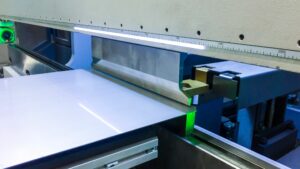
The hydraulic press brake is classified into two;
Nut-stop hydraulic
This variant of hydraulic uses a nut-stop as a mechanical stopper during the bending process, to guarantee precise control.
It’ll come in handy when working on a project that requires detailed precision.
Synchro hydraulic
The synchro hydraulic has a digital control system that facilitates the movement of multiple hydraulic cylinders to create an accurate shape. It’s also known for its high precision, so you can use it to achieve different shapes on a variety of workpieces.
Which is Better Mechanical or Hydraulic Press Brakes?
A hydraulic press brake is a better option as it easily performs complex tasks, has more precision bends, and is a safer press brake.
Pneumatic Press Brakes
Pneumatic press brakes known as ‘air press brakes” use pneumatic (air) power for bending metal sheets.
What types of materials are best suited for
Pneumatic press brakes work best with light gauge materials like;
- Thin Sheet Metal Work
- Plastics
- Non-Ferrous Metal
Common Applications
Typical applications of pneumatic brakes are;
- Forming and Shaping Operation
- Precision and Delicate Parts
ADVANTAGES
- They are more affordable compared to hydraulics
- Pneumatics offers fast set-up and adjustment time
- It requires minimal training to operate
DISADVANTAGES
- They cannot bend any thick material due to their low force capacity
- It’s noisy compared to hydraulic press brakes
All-electric press brakes
The currently available electric press brake systems are the most effective and modernized edition of all press brake machines in history.
Apart from simply making the process more effective and promoting fast functioning and manufacturing, an electric press brake has also shown great progress in the overall safety of the working.
They are also highly accurate when compared to relatively older methods of functioning.
How does it work?
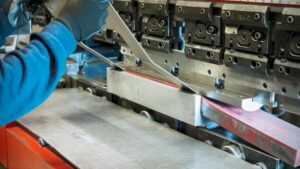
An electric press brake system is completely free from any form of hydraulic support and run entirely on electricity. That being the case, it is relatively eco-friendly and offer greater levels of safety and accuracy.
This is all thanks to the recent advances and progress in the mechanics field.
In the electric press brake, the movable part is solely operated by electricity rather than any form of direct force, which is the case in hydraulic systems. This is brought about with good precision with the help of several in-built attachments and software control.
Benefits
With such high degrees of innovation and automation, these devices greatly decrease production costs. They also help reduce production costs, as well as energy expenditure.
As a result of the above, they are considered highly economical options compared to the others in the line.
CNC Press Brakes
A CNC press brake is a new model of press brake and uses servo or electric motors as its primary source of power for its various machine movement.
CNC press brakes have the highest precision, as it utilizes computer technology to achieve optimum efficiency.
Plus, you don’t have to worry about oil leaks as there’s no use of hydraulic oil.
What types of materials are best suited for
CNC press brake is capable of bending various metals like;
- Stainless Steel
- Aluminum
- Exotic Metals and Alloys
- Mild Steel
Common Applications
Some applications of the CNC press brake include;
- Heavy Plate Bending
- Customized Fabrication
- Complex and Multi-Bend Parts
ADVANTAGES
- CNC brakes offer consistent bending quality throughout production runs
- It often has built-in data-logging capabilities
- CNC brakes reduce material waste and scrap
DISADVANTAGES
- It’s expensive to purchase
- It requires more specialized maintenance
- Operators must have a certain level of technical expertise to perform any task using the CNC brakes
Tandem Press Brake
A tandem press brake is a configuration of multiple press brakes working together to produce a higher bending capacity. It’s familiar for its capability in fabricating and manufacturing thick sheet metal components.
With tandem press brakes, you get to experience better accuracy and flexibility.
What types of materials are best suited for
Tandem brakes are best suited for;
- Titanium
- Copper and Brass
- Non- Ferrous Metal
Common Applications
The most common uses of the tandem press breaks are in;
- Aerospace and Defense Industries
- Mass production
- Automotive Body-In-White Manufacturing
ADVANTAGES
Some of the main benefits that tandem press brakes offer are:
- Tandem brakes are ideal for bending long and wide parts (bending length up to 18m)
- Simultaneous bending of complex parts
- Increased Bending Capacity: With its unique design, tandem press brakes can handle larger and thicker materials, increasing bending capacity and flexibility in the manufacturing process.
- Greater Precision and Accuracy: The tandem press brake’s multiple press brakes working together provide superior precision and accuracy in the bending process.
- Versatility: Tandem press brakes can handle a wide range of materials and offer flexibility in the manufacturing process, making them ideal for various applications.
- Increased Productivity: With its larger bending capacity and precision, the tandem press brake can increase productivity and efficiency, reducing production time and costs.
- Cost-Effective: Using a tandem press brake can be more cost-effective than purchasing multiple single press brakes, reducing overall equipment costs.
DISADVANTAGES
- Complex Synchronization
- Limited flexibility when dealing with certain products
- It may require additional training to operate
Hybrid press brakes
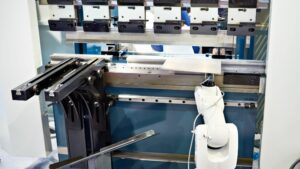
As the name subtly hints, the hybrid press brake is a machine that combines the best features of both hydraulic and all-electric press brake machines.
Unlike hydraulic press brakes, hybrid machines do not have any gear pumps, but they operate with the assistance of hydraulics in the process of metal bending.
Similar to the all-electric counterpart, they help work in a more environmentally friendly manner. They turn off on their own when not in use.
Parts of a hybrid press brake
To understand the functioning, it is important to first have an idea about how the machine is structured. The basic outline of a hybrid press brake system is composed of the following parts.
Machine frame:
The frame itself is further inclusive of left and right columns, oil tanks, working tables, and cylinders for when the crowning system is used. Along with this, there are other supportive parts as well. The crowning system is mainly for the compensation of the work deflection which is prone to occur in the working table.
This is important to make the working table produce pre-deformation which is used to track the movements of the slider. These movements are then studied to control the angle change of the workpiece along with control of the bending length and tolerance range.
Sliding block:
It is composed of the left and right cylinders connected and secured together with the help of bolts, along with the system comprising of the piston rod and slider joined with the spherical blocks and screws. This block is in association with the frame through the guide rail. On moving the slider, the position data acquired is instantly fed to the CNC system. Then, the measures help in proper control of the output flow of the electro-hydraulic valves and the synchronization.
Crowning table:
It helps in ensuring the parallel fixation of the working table and sliding block throughout the process.
Light curtain:
It is an electrosensitive protective measure to ensure safety.
Bending angle laser detection device:
In most cases, it is software-mediated and helps in improving productivity and quality.
Bending mold and clamping:
It has two parts, the upper bending punch, and the bottom die.
Front support and back gauge:
The font support is a standard part of the working table, while the back gauge is a floor standing independent structure.
Hydraulic system:
It is similar to the hydraulic press brake, but a simpler version.
CNC control system:
This is in charge of all the calculations and corrections.
Benefits of a hybrid press brake
As was mentioned earlier, a hybrid press brake holds all the good stuff from both hydraulic and all-electric press brake systems.
However, they cannot be employed in industries that work with high energy levels which exceed 250 metric tonnes.
They are highly sustainable and environmentally friendly, unlike hydraulic systems which do not possess any auto shutting down mechanisms.
What Factors Should Be Considered When Choosing a Press Brake Type?

These are the important factors you should look out for when choosing a press brake type;
- Tonnage: You need to choose a press brake that can handle the required workload. So, first, determine the material length and thickness you will be working with.
- Tooling Compatibility: You need to be sure that the press brake works well with the press brake tooling you have.
- Automation and Integration: You can choose to go for a press brake with extra automation features.
How to Choose the Right Type of Press Brake For Your Needs?
Before choosing a press brake, you should take note of the following tips;
- Safety precautions: Make sure that the press brake you go for comes with adequate safety features.
- Pick the Right Type For Your Needs: There are different types of press brakes, so compare your choices before purchasing.
- Budget: Map out a budget that will guide you as you purchase and operate the press brake.
- Know your Requirements: You need to know the materials you are working with and how much production would be done.
What are the Different Types of Press Brake Bends?
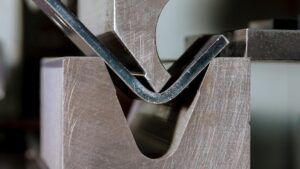
Press brakes come with different press brake bending methods. Let us take a look at the three types below;
Air Bending
In air bending, the workpiece will only come into contact with the punch tip and the edge of the die. What happens is that the punch is forced to pass the die top through the V-opening without directly touching the bottom of the V.
The size of the V-opening controls the inside radius of the bend because the workpiece is not penetrated by the punch tip. An operator can switch the bottom die to make adjustments to the design or compensate for mistakes.
Bottom Bending
With the bottom bending method, the die angles and that of the workpiece should match. After bottoming the workpiece against the die, then the bending angle is created by forcing the radius of the punch into the piece. The material springs back to meet the die once released. Ensure you compensate for material spring back.
Coining
In this method, the workpiece is stamped between a die and a punch. With the right amount of pressing force, the punch tip can penetrate and flow into the material. The coining method can be repeated and has great accuracy, plus its a great way to rectify material springback.
How to Choose the Right Type of Press Brake Bend For You?
Before you choose a press brake bend, consider these factors;
- Versatility and accuracy
- Tooling selection
- Space occupied
Conclusion
Press brakes will forever take the front stage when it comes to bending and folding metal materials. However, you should know that not all metals have the same level of thickness and width, hence your choice of bending machine will highly depend on that factor.
In the end, make sure to do your research before making a choice.
FAQ
1. How Has Advancements in Technology Affected the Evolution of Press Brake Types Over Time?
As time progresses, a lot of press brake manufacturers have been developing modern press brakes to keep up. Thanks to advanced technology, these brakes have better control systems, more precision, and increased safety.
2. Can Different Press Brake Types be Used Together in a Manufacturing Process?
In a manufacturing process, it is possible to use different types of press brakes for various production stages. For example, a hydraulic press brake might be used for heavy-duty bending operations, while a mechanical press brake would be preferred for high-speed bending operations.


